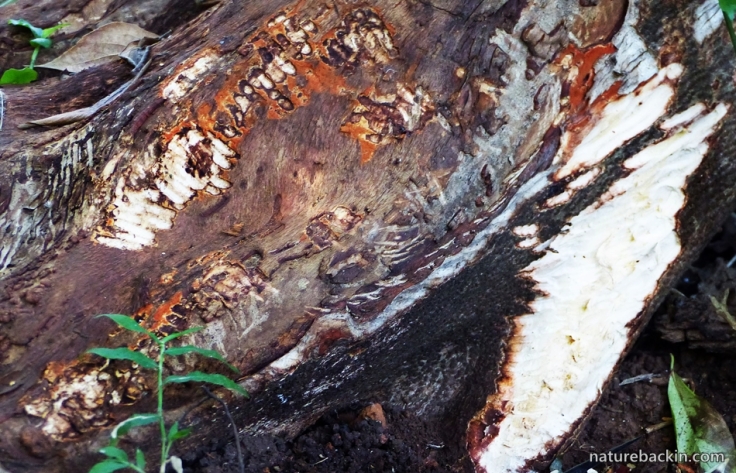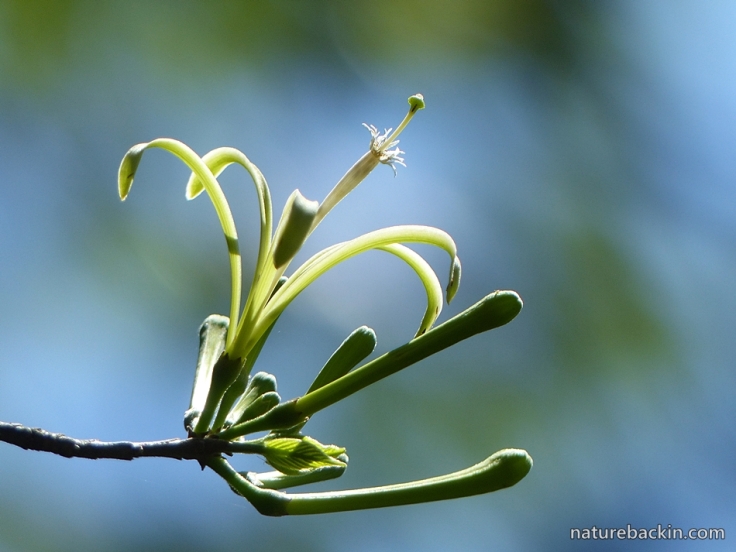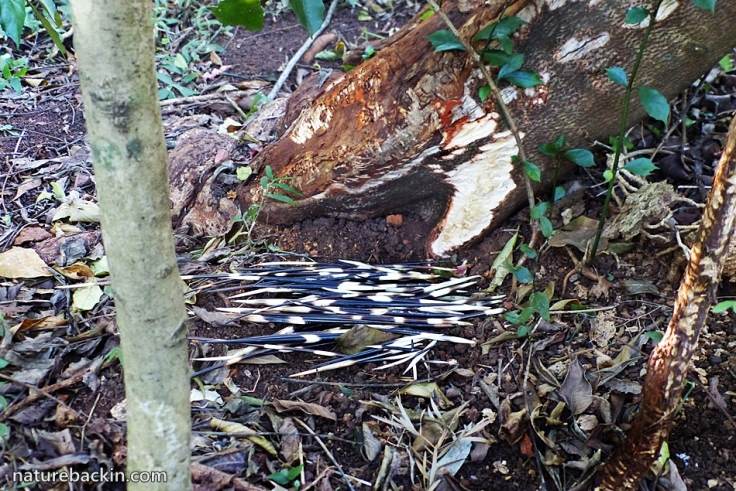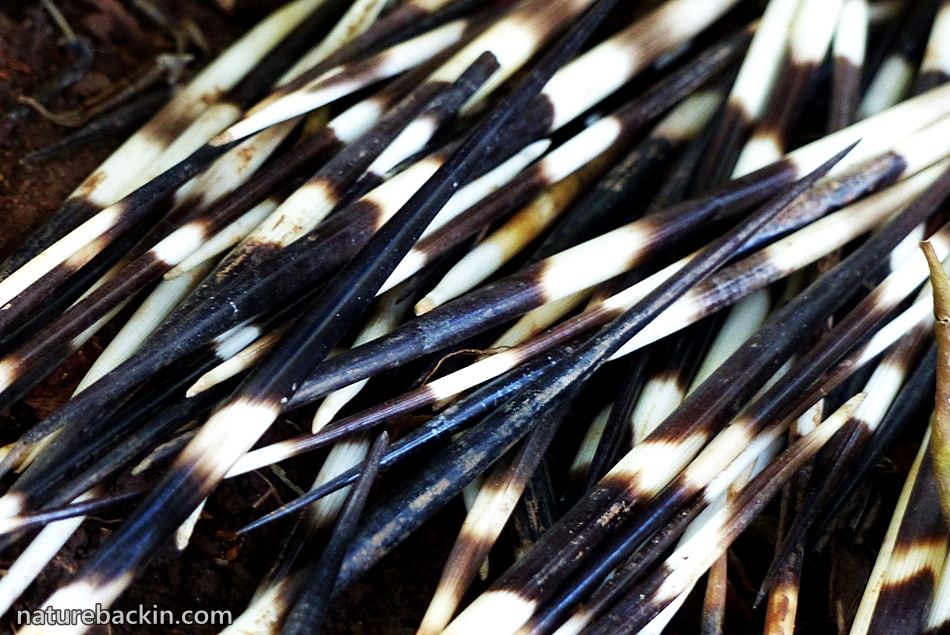The ability of porcupines to survive in areas proximate to farmlands and suburbia is a double-edged sword for them, because their initial success results in their ongoing persecution by humans.
Porcupines come into conflict with us humans when they eat or damage crops and garden plants, damage fences and/or burrow under fences, chew on irrigation pipes or strip bark off trees. Additionally, their burrows can be obstacles to farm vehicles, and their abandoned burrows may harbour other animals that are also regarded as ‘problem animals’.
All of the above has led to porcupines being routinely killed, especially in farmlands where they have the status of vermin. Killing methods include shooting, poisoning, snaring, or setting baited traps to catch porcupines that are then clubbed or shot.
Despite all of this, a group of porcupines manage to survive on the margins of the commercial plantation behind our house. They shelter in burrows and at night they forage over significant distances, searching for a variety of plants and plant material. Being nocturnal, they visit our garden after dark in their ongoing quest for their favourite edible plants. To get in, they squeeze under the gate or even dig under our fence. On some visits they dig up and eat tubers or corms. Occasionally they also gnaw bark off certain trees.

As porcupines are nocturnal and very shy, I have not been able to photograph the porcupines that visit our garden regularly. This photo of a large porcupine is clipped from video footage taken by a borrowed trail camera that we set up in the plantation behind our garden
In addition to eating tubers, bulbs and roots, porcupines also eat shoots, stems and leaves of a variety of plants, tree bark, and fallen fruit and seedpods. In our garden the tubers and roots of Arum Lilies, Crocosmia, Leopard lilies and Freezias are among those enjoyed by porcupines. Sometimes their excavations can be impressive, but usually sufficient offsets and small corms and tubers are dispersed in the diggings so that the plants regenerate in the next season.
Our two dogs have learned to give visiting porcupines a wide berth and because of this “respect” they co-exist with the visiting porcupines without conflict.

A porcupine gnawed on the trunk of the Wild Honey-suckle tree (Turraea floribunda) in our garden about two years ago. The tree has recovered with no apparent adverse effects

The Wild Honey-suckle tree proceeded to flower the following spring. The parts of the trunk where the bark have been stripped off appear to have healed.
Porcupines are often regarded as wasteful feeders and their digging and burrowing is considered to be nothing short of damage. But ecologically speaking, in natural habitats porcupines can be seen as beneficial ecosystem engineers. Their diggings can accumulate water and organic material, including seed, and so have a positive effect on biodiversity, and their foraging habits can contribute to the regeneration of plants that propagate through corms and bulbs.
This video features clips taken using a trail camera of an adult porcupine drinking water, and even lying down as if to rest, on a hot night during March earlier this year. In the Eucalyptus plantation behind our garden, the thirsty trees mean that the local stream remains dry, even in the rainy season. To mitigate the effects, we have placed a water container, which we keep topped up with water, outside our garden providing the local wildlife with access to drinking water.
Porcupines in South Africa, Hystrix africaeaustralis, are also known as Cape Porcupines. They are monogamous and usually produce a small litter once annually, with an average of only two young per litter. Breeding pairs live together and both parents contribute to raising and protecting the young, resulting in a relatively high survival level for the small number of babies. Sub-adults and juveniles, offspring from previous litters, often live in the same burrows as the breeding pair. Subordinate females in the group do not breed. The dispersal of sub-adults depends on population density, as well as on the dispersion and abundance of food sources.
Despite porcupines being widespread across much of South Africa, where levels of persecution are high, local extinctions are already happening. Their reproduction rates are slow and there is no room for complacency, even though porcupines are still relatively common.
In addition to the persecution of porcupines in farmlands, porcupines are hunted for their meat and they are also common road-kill victims on our roads, and added to that, increasingly they are killed specifically for their quills.

In this still from trail camera footage, the quills on this porcupine can be clearly seen. When threatened a porcupine will raise its quills and so appear larger, and may defensively rattle its tail quills, making a noise that sounds a bit like shaking a large sheet of corrugated iron. To protect itself, a porcupine can also run backwards into its pursuer using its quills defensively. If contact is made the porcupine’s quills can become dislodged and embedded in face and body of its pursuer. It is not true that porcupines can “shoot” their quills
Unfortunately for porcupines, their quills have become popular for use in the fashion industry and in décor items. Some retailers may claim that quills sold have all been found after being naturally shed, but in fact animals are being killed specifically for the increasingly lucrative trade in quills, as described by Chevallier and Ashton (2006) in their report on this trade.

These pictures are randomly selected from Google images and provide examples of how porcupine quills are used in décor items

Next to the gnawed base of the tree in our garden, I placed all the quills we have found in our garden and the adjacent plantation. Despite a highly active resident group these are the only naturally shed quills we have found in the past 15 years. To keep up with the demand for quills in the retail trade, found quills are insufficient, and in any case are likely to be dirty or damaged, and consequently many animals are killed for their quills
Because many people are unaware that quills are obtained from porcupines that have been killed, with many being killed specifically for the quills trade, there have been campaigns to raise public awareness of the plight of porcupines in South Africa and asking consumers to avoid buying porcupine quill items. So if you are ever tempted to buy any such products, please, just say no.

This is a poster from the International Fund for Animal Welfare (IFAW) asking people not to buy products containing porcupine quills
Although more needs to be learnt about the habits, effects and distribution of porcupines, based on what is already known, several organisations are formulating recommendations for more sustainable ways of managing porcupines where they are a nuisance, and for more ethical and sustainable ways of harvesting their quills. They also want to raise awareness of the ecological value of the foraging and digging behaviour of porcupines as a “driver of diversity” (The Red List of Mammals of South Africa, Lesotho and Swaziland (2016, p.4).
But meanwhile back at the bottom of our garden, we were delighted to find that the trail camera had captured footage of a pair of juvenile porcupines apparently playing. At first they are seen approaching the water trough in the company of a sub-adult porcupine. After the sub-adult moves off, the clips show the juveniles playing together like two prickly kittens. Note that this footage has not been speeded up! In some of the sequences it looks as though the youngsters are practicing the advance-rapidly-in-reverse manoeuvre they may need to use defensively when they are older. In the meantime it all looks to be great fun!
Sources:
Chevallier, Nick and Ashton, Belinda. 2006. A Report on the Porcupine Quill Trade in South Africa. This report was commissioned by IFAW (International Fund for Animal Welfare) http://media.withtank.com/23fd88d381/porcupine_quill_trade.pdf
Our Wild Neighbours. Living near porcupines. https://wildneighbours.com/living-near-porcupines/
The Red List of Mammals of South Africa, Lesotho and Swaziland. 2016. Hystrix africaeaustralis. https://www.ewt.org.za/reddata/pdf/Rodentia(10)/2016%20Mammal%20Red%20List_Hystrix%20africaeaustralis_LC.pdf
Van Aarde, Rudi. 1998. An Ecological Perspective of Reproduction in the Cape Porcupine. Transactions of the Royal Society of South Africa. 53(2): 237-243. Published online: 13 Apr 2010. http://www.ceru.up.ac.za/downloads/ecological_perspective_reproduction_porcupine.pdf
Posted by Carol









May 10, 2020 at 11:19 pm
I just found this post of yours as a recommended link! A good read. I like porcupines and their place on the Native American medicine wheel of Innocence, holding the powerful medicine of faith and trust. While quill work is controversial, I know it is important to the cultural reclaiming and recovery work of my Native friends who live in poverty on the reservation. But I do understand and agree with you about the exploitation of this beautiful innocent and playful creature.
LikeLiked by 1 person
May 11, 2020 at 4:01 pm
Yes, its complicated and like many issues, utilizing porcupines for their quills needs to be considered in context.
LikeLike
July 8, 2018 at 12:45 pm
Carol, this article rates among your best: hard-hitting and filled with interesting facts – a good read (and view) all round.
LikeLiked by 1 person
July 8, 2018 at 8:32 pm
Thanks Anne. I really appreciate the feedback. I try to keep a balance between lighter and more celebratory posts and some posts that are longer and a bit more intense, and require more investigation on my side prior to writing them. As so much we read about in the world is sad and bad and depressing, I am anxious about adding to that sad burden.
LikeLike
July 8, 2018 at 12:26 am
As someone ahead of me said: we certainly are “the most destructive species on earth”. How very utterly sad! I can’t say I found the examples that used the quills all that enticing. To me it just seems to convey this idea that humans have dominion over the critters around us – to the detriment of all others. Yet one more example of extinguishing everything around us until there’s nothing left. I can’t help but wonder how much better this planet might be without humans…
LikeLiked by 1 person
July 8, 2018 at 8:06 pm
It is utterly sad. The idea that humans do and indeed ought to have dominion over nature and all other creatures is pernicious and pervasive. It is hard not to be discouraged.
LikeLike
July 6, 2018 at 9:20 pm
So many problems in the animal world are a result of the continual growth of the human population, which doesn’t look like ending any time soon. Urban centers expand into farmland. Farmland expands into wild areas. Wild areas are exploited for timber and minerals. Despite a growing awareness of these issues I don’t see the trend stopping any time soon. It doesn’t bode well for nature, that’s for sure. Thanks for another informative post. It never hurts to get the word out.
LikeLiked by 1 person
July 8, 2018 at 7:59 pm
Sadly true that its hard to see such trends stopping and that increasing awareness in certain circles is not enough.
LikeLiked by 1 person
July 6, 2018 at 5:04 pm
Terrific write-up on Porkies.
LikeLiked by 1 person
July 8, 2018 at 7:26 pm
Thanks so much Sherrry.
LikeLike
July 6, 2018 at 10:35 am
Fortunately the fashion for quill accessories seems to have waned – I have not seen any for a long time. However – it may still be all the rage in Europe or America or Asia….
LikeLiked by 1 person
July 6, 2018 at 11:27 am
I hope that it is on the wane, but fads come and go and come back again … . I seem to remember seeing them sold at airport souvenir shops not so long ago.
LikeLike
July 6, 2018 at 10:31 am
Carol, there is always so much to learn from your posts. Such wonderful creatures, about which I knew next to nothing. The footage of the babies is marvellous – and offers a little hope to mitigate the dangers and destruction that these lovely animals are facing. In our old home we had half a dozen hedgehogs living in our garden and captured some wonderful footage of their nocturnal activities. Sadly, here in rural Cornwall we’ve never seen a trace of a hedgehog.
LikeLiked by 1 person
July 6, 2018 at 11:26 am
There is something so endearing about a hedgehog – and surely not just because of Beatrix Potter? Sad that they too are now so threatened.
LikeLiked by 1 person
July 6, 2018 at 2:18 am
How lucky you are to have these shy creatures visit your garden, and how horrifying to know that another animal is being wantonly killed in enormous numbers to satisfy human greed…
LikeLiked by 1 person
July 6, 2018 at 11:23 am
Yes we are lucky. We are happy to share our plants with them, as that is what a wildlife-friendly garden is all about! As I read for this post I learned so much about porcupines that was so interesting. I battled to wrestle all that I learned into a manageable-sized post. It is so sad that they are killed with impunity.
LikeLiked by 1 person
July 5, 2018 at 11:38 pm
Thank you for such an interesting and informative post. I’m quite unfamiliar with porcupines and enjoyed learning about them. It’s distressing to read about their plight though. There seems to be no end to the thoughtlessness, cruelty and greed of some humans, the most destructive species on earth.
LikeLiked by 1 person
July 6, 2018 at 10:17 am
Thanks Jane. Yes it is distressing and disturbing. Farming is so often the coalface for human-animal confrontations. Let us hope that more sustainable strategies can be found for a lot of these problems.
LikeLiked by 1 person
July 5, 2018 at 9:48 pm
A very interesting and informative post. I had no idea porcupines were killed for decorations…but I am not surprised. That is who we are – we humans. Not very good at thinking ahead, only thinking about making money. Our hedgehogs are often killed on the roads, and I have even seen dogs running lose, pitbulls and amstaffs, chasing and eating them in parks. My own dog is taught not to bark or touch them – we have two little sweeties in our garden.
LikeLiked by 1 person
July 6, 2018 at 10:03 am
Your hedgehogs are fortunate to have found a haven, and in turn you are fortunate to have them to visit. I don’t understand why so many people (including self-declared animal lovers) think it is okay for their dogs to chase and harass wildlife. (And some of these same folks get holier-than-thou about cats … ! Of course, cats too should have their hunting opportunities limited as far as possible. )
LikeLiked by 1 person
July 5, 2018 at 9:14 pm
A most informative post. I knew little about porcupines but have always liked them. Much wildlife here has seen its habitat shrink because of man’s activities and are considered pests. I assume it’s the case there as well.
LikeLiked by 1 person
July 6, 2018 at 9:29 am
Thanks Belinda. I gather that the Cape porcupine differs quite significantly from the North American porcupines. Unfortunately you are correct and what you describe is happening to wildlife where you are, applies here too.
LikeLike
July 5, 2018 at 9:03 pm
This is a great post for raising awareness. Using animals for decor is pretty tasteless when you think about it, which most, unfortunately, don’t. I enjoyed the videos, esp. the ‘kits’ – love the punk ‘Mohawk’ hair-dos!
LikeLiked by 1 person
July 6, 2018 at 9:26 am
Wild animals already have enough problems without the demands of the souvenir trade in animal products, which deals in so much rather tacky ephemera. Glad you liked the videos. The youngsters are very sweet, and the adults’ hair-dos seem to convey attitude!
LikeLiked by 1 person
July 5, 2018 at 8:51 pm
I find myself torn between being fascinated by this article and revulsed by the barbaric and selfish activies of manunkind. We have porcupines here and they are often the victims of traffic which is bad enough but to understand that they are considered vermin and killed because they are a nuisance and then further that vain selfish and greedy for compliments humans slay them for their quills, the very mechanism they have devised for their own protection sickens me beyond my meagre dictionary of words. I will now find out if farmers in this country do the same as in yours. I hope not but I suspect they probably do.
LikeLiked by 1 person
July 6, 2018 at 9:09 am
I had to harden my heart to write this post, and I agree with all you say. I usually try to focus more on the upbeat, but that is not always realistic. Sorry that this post is distressing. I have read that North American porcupines are much smaller and slower than the Cape Porcupine. I was surprised to read that they are arboreal. They live mostly in forest habitats and so although there may be some conflict with foresters, they are not usually found in farmlands. That so many porcupines die on the roads is awful. I gather that North American crafters who use quills often gather quills from road-kills. I suppose it is sensible to utilise such a “resource”, but …
LikeLiked by 1 person
July 6, 2018 at 2:56 pm
But ….. if people drove with more care and attention and the appreciation that there are likely to be porkies crossing (or indeed other wildlife) then there would be less roadkill. It’s a simple matter of being observant and driving a little more slowly and yes, sometimes it is impossible to avoid the horror of hitting something but only sometimes. I couldn’t bear to have anything made from the quills of a beautiful animal. I’m such a bozo that if I found a dead porcupine I would probably bury it and certainly put it to the side of the road for the carrion to carry on (sorry couldn’t resist that one) nature’s intentional chain.
LikeLiked by 1 person
July 8, 2018 at 7:24 pm
I am on the same wavelength as you on this. And re the pun. I also find puns irresistible, especially rotten ones 🙂 🙂
LikeLiked by 1 person
July 8, 2018 at 8:59 pm
😊
LikeLike
July 5, 2018 at 8:39 pm
I wasn’t aware that porcupine quills were used by man (and woman). The things we get up to….
You have your porcupine neighbour, and we have been equally charmed to find we share our garden with the increasingly rare hedgehog. He/she isn’t keen on being photographed, though, but I hope will go on appreciating this particular address.
LikeLiked by 1 person
July 6, 2018 at 5:59 am
How lovely to have a hedgehog visiting. If you haven’t seen it already you might like to visit the blog Little Silver Hedgehog. It has interesting posts from a blogger who runs a hedgehog hospital in York. She makes and sells silver jewellery to fund the invaluable work she does. See https://littlesilverhedgehog.com
LikeLiked by 1 person
July 6, 2018 at 8:06 am
Oh thanks! I’ll enjoy exploring her site. Though we’re pretty near York, I hadn’t come across her.
LikeLiked by 1 person